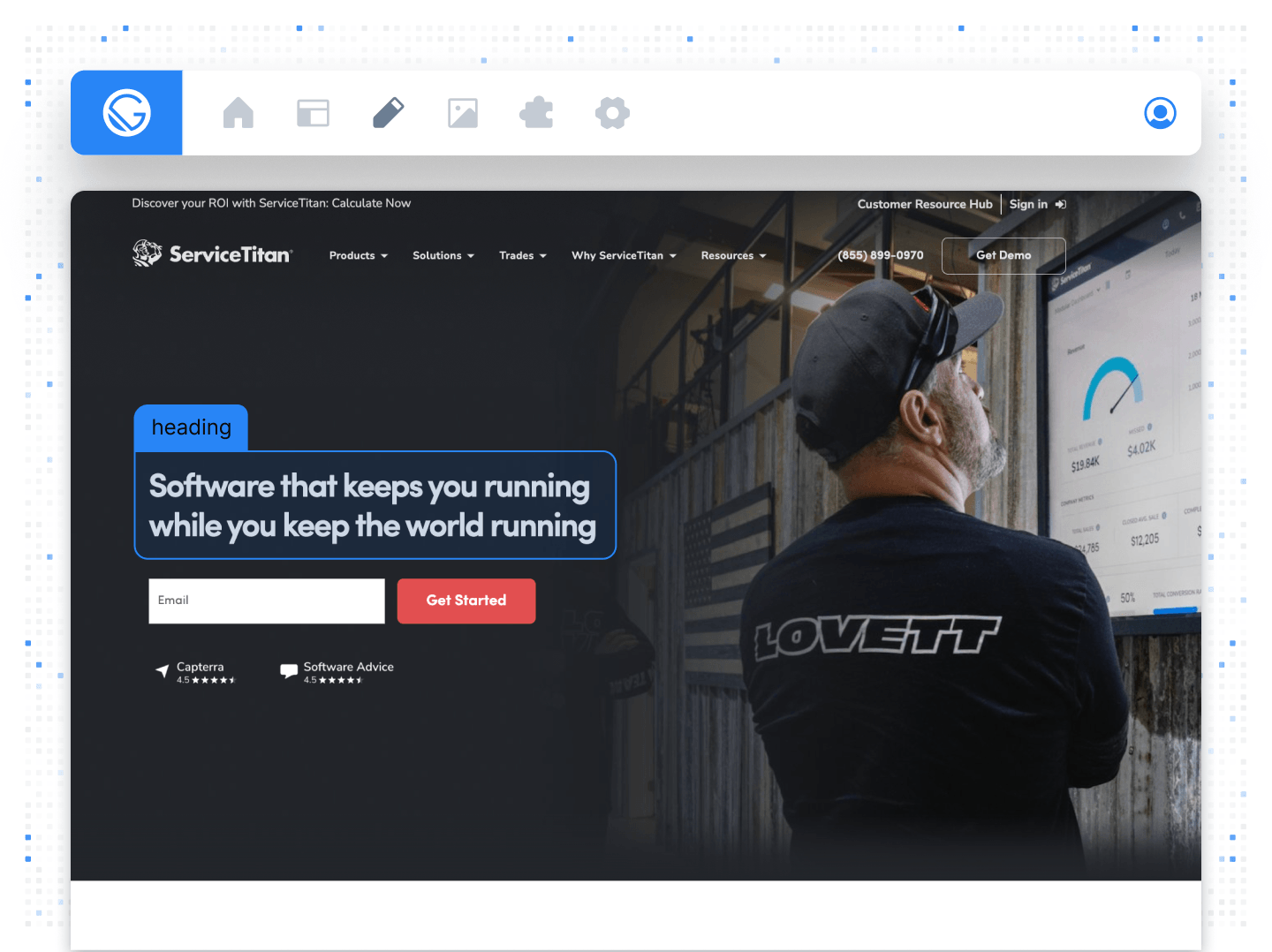Why is Traditional Website Management Broken?
Picture this: A company pours months—sometimes over a year—into a massive website redesign. The launch is treated as the finish line. Leadership checks it off the list, marketing moves on to new campaigns, and the website? It sits untouched, aside from a few minor updates.
This one-off redesign model has been the standard for decades: invest heavily every 3–5 years, build the “perfect” site, then let it stagnate until the next overhaul. But in today’s fast-moving landscape, this approach is outdated, ineffective, and costly.
While the business evolves, the website doesn’t. It quickly becomes outdated, slow to adapt, and disconnected from go-to-market needs. Content updates take too long, UX suffers, and marketing teams find themselves working around the site’s limitations rather than leveraging it as a growth engine.
Websites Aren’t a One-Time Fix
Still, many companies treat their website as a one-and-done project—or worse, a dreaded burden that disrupts the team every few years.
To succeed, this mindset must change. Winning companies treat their websites like products—continuously evolving, adapting, and optimizing just like their core offerings. The reality is that traditional website management models simply aren’t built for this level of speed, flexibility, and scalability.
At Webstacks, we saw this gap firsthand. While product teams embraced agile development, their marketing counterparts struggled with slow, disconnected website operations and outdated tech stacks that created more problems than solutions.
So we asked: Why weren’t companies applying the same agile approach to their websites?
This ultimately led us to develop one of our core services: Website Product Teams.
What is a Website Product Team?
This thinking led us to develop the Website Product Team—a dedicated, integrated team of designers, developers, and strategists who treat a company's website as a product. Instead of reactive fixes and long development cycles, this approach ensures that a website is always evolving, constantly being optimized, and continually maximizing its ability to achieve the business’s goals.
Unlike traditional website management models, a Website Product Team functions as an extension of the marketing department rather than an external vendor or siloed agency. This means faster execution, better collaboration, and a website that adapts at the speed of business.
By operating under an agile framework, a Website Product Team delivers updates in structured sprints, ensuring that UX improvements, conversion optimizations, and new feature rollouts happen continuously—not just when a redesign is overdue. More importantly, a Website Product Team eliminates common bottlenecks that slow down marketing teams. No more waiting weeks for internal dev resources, relying on scattered freelancers, or dealing with slow-moving partners.
With a Website Product Team, companies finally have a dedicated, high-velocity resource to keep their most important digital asset working for them—every single day.
Why Should Your Website Be Treated Like a Product?
Just like software, a website that doesn’t evolve quickly becomes outdated, underperforms, and fails to meet business needs.
Think about it—your product doesn’t stay the same for years, so why should your website?
Instead of aiming for a “perfect” site at launch, the better approach is to start with a strong foundation and continuously improve. This is the essence of agile website management.
Agile Websites Stay Ahead, Stagnant Ones Fall Behind
🔹 Launch Fast, Iterate Often → A website should be treated like a SaaS product—built to ship updates and new features frequently.
🔹 Fixed Cycles, Predictable Progress → Working in structured sprints ensures that progress happens on a regular basis—not sporadically. It keeps teams accountable and maximizes your output.
🔹 Marketing Without Roadblocks → A rigid website slows everything down. If every update requires months of planning or dev support, growth stalls, campaigns suffer, and opportunities are lost.
It’s actually very simple—the companies that embrace continuous iteration win. If your website can’t move at the speed of your business, it’s holding you back.
What Are the Benefits of a Website Product Team?
Most companies rely on disconnected, inefficient website management models—overloaded in-house dev teams, slow-moving agencies, or unreliable freelancers. The result? Missed opportunities, outdated experiences, and marketing teams struggling to execute. A Website Product Team eliminates these problems by providing a dedicated, agile team focused exclusively on growing and optimizing your website.
Here’s how:
Speed & Efficiency
Traditional website management often results in slow-moving updates, bottlenecks, and missed opportunities. A Website Product Team ensures that:
Scalability & Reliability
As companies grow, website demands increase—but internal teams often can’t scale fast enough to keep up. A Website Product Team provides:
Integrated, Cross-Functional Expertise
Website Product Teams are made up of versatile experts who know how to build, optimize, and grow a high-performing website. Instead of being limited to one function, they bring a mix of skills across design, development, and strategy, making them adaptable to whatever the website needs next.
Unlike traditional agencies or fragmented teams, a Website Product Team is in lockstep with your team, ensuring seamless collaboration.
Agility & Adaptability
Marketing priorities change fast, and your website needs to keep up. A WPT is designed for rapid iteration and flexibility, allowing you to:
Improved Collaboration Between Marketers & Developers
One of the biggest challenges in website management is the disconnect between marketing and development teams. A Website Product Team:
How Do High-Growth SaaS Companies Benefit from Website Product Teams?
Fast-growing SaaS companies need websites that can scale as quickly as they do—without technical bottlenecks or slow-moving development cycles. A Website Product Team ensures their website remains agile, optimized, and aligned with their business goals.
ServiceTitan: Scaling Website Operations to Support Growth

As ServiceTitan grew into a $9.5B SaaS leader, their marketing website struggled to keep up with the company’s rapid expansion. Initially constrained by HubSpot CMS and inconsistent branding, they needed a scalable website to support rapid content production and marketing initiatives.
By leveraging a Website Product Team, ServiceTitan:
Calendly: Evolving a Website to Match a Growing Business Strategy

As Calendly expanded beyond its PLG roots and into the enterprise market, it needed a website that could support a more complex sales motion. After an initial rebrand left room for improvement, Calendly partnered with a Website Product Team to make rapid enhancements and ensure their site reflected their new positioning.
With Webstacks, Calendly:
Semgrep: A Scalable Website to Support a Growing Product Line

When Semgrep transitioned from its original brand (r2c) to a more sophisticated, developer-focused security platform, it needed a website that could support new products, a refined go-to-market strategy, and a better content experience.
With a Website Product Team, Semgrep:
As you can see, the beauty of a Website Product Team is its versatility. It’s not limited to redesigns or CMS migrations—it adapts to whatever your website needs. Whether it's scaling content production, optimizing performance, or launching new features, Webstacks can mold to your goals and evolve alongside your business.
Is a Website Product Team Right for You?
If your company’s website feels more like a bottleneck than a growth engine, it’s time for a new approach.
A Website Product Team is the best solution for companies that:
✅ Have a growing backlog of website updates but lack the resources to execute them quickly.
✅ Rely on multiple stakeholders—marketing, sales, customer success, and beyond—who all need a website that keeps up with their initiatives.
✅ Want a faster, more scalable way to manage their website, without overloading internal teams or waiting months for updates.
The future of website management isn’t slow, fragmented, or reactive—it’s agile, iterative, and built for continuous growth, just like product development.
As we say at Webstacks—your website is never finished. So you should treat it that way.












